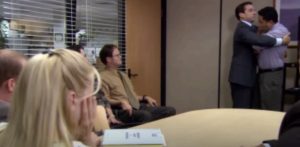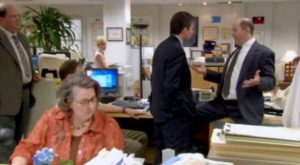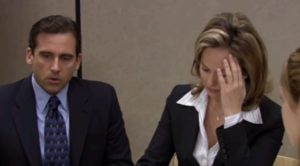45 The Office (2005-2013)
Representations of Difference, Power, and Discrimination in The Office
By (Anonymous)
Have you ever imagined what a documentary about the everyday American workplace would look like? Not very interesting, you may be thinking. However, add in sarcasm, drama, and exaggerated plotlines, and you have the recipe for the perfect comedy. The Office is a mockumentary show which examines a group of ordinary office workers at a simple paper company. In this unique genre, a camera crew discretely follows the shenanigans and happenings of the mundane office environment, allowing for a seemingly raw and intimate viewing experience to the audience.
The Office explores several issues in difference, power, and discrimination through the elements of editing, literary design, mise en scène, sound design, and cinematography. These elements are collectively used to create jokes that shock the audience with their absurdity, essentially exposing how issues of difference, power, and discrimination, genuinely appear in real-life workplaces by mocking them. In particular, the series especially identifies gender and sexuality issues through the various film elements.
The Office is a show that I grew up watching with my sister and dad at an early age. It’s more than likely some aspect of my humor as a teenager was inspired by the show’s controversial humor. Rewatching the show a few times with a broader perspective and understanding of what the jokes really meant has shifted my view on the series a few times. At first, I saw the problematic elements such as the blunt racism and sexism as potentially offensive to the groups the jokes target. However, deeper consideration into the show’s intention led me to see the show, including the offensive jokes, as a satire. It mocks the real world American office workplace and exposes how power structures and discrimination genuinely exist in these spaces, albeit not usually at the absurd levels the show portrays.
Understanding the intentionality behind crafting character placements and the setting of The Office can help with understanding how the show displays issues in difference, power, and discrimination. The show is set in Scranton, PA, a city in America that embodies “white America” well with the population being over 80 percent white. The unremarkable and ambiguous setting allows the show to resonate with its white American audience by putting them in a highly relatable setting. The mundane office setting further relates to viewers through a standard “American workplace” as seen through the cookie cutter desks, uniform cubicles, and generic office park. This ordinary setting serves as a clean backdrop to highlight the social commentary the show makes in pointing out how systemic issues play out in ordinary places. Each character’s race and gender is another key aspect to the context of The Office that defines how it makes a statement on DPD issues. The show displays a clearly patriarchal and homogenous workforce, with the office being almost entirely white and male dominated, almost to a satirical level. Jokes in the show are often rooted in this homogeneity, making viewers question this blatantly problematic workplace structure.
Difference can be understood in The Office through examining the character identities and how they play into the plot of the series. Workers in the office are regularly treated in certain ways due to their race and sexuality. Film elements such as editing and sound design further exaggerate how the show displays issues around difference. For example, Stanley is the only black man who works in the office and is always the subject of jokes that tie into his race. When Michael has a statement to make about black people, he always comes to Stanley as a representative of his race. During these scenes, sound design is used to highlight Stanley’s discomfort with the absence of a laugh track. Moments of silence combined with whip shots exaggerate the absurdity of these situations. In a similar fashion, difference is highlighted in the way the only gay man in the office, Oscar, is treated. Michael’s over the top attempts to sincerely express his acceptance of Oscar’s sexuality ultimately end up undermining his intentions. In “Gay Witch Hunt” (Season 3, Episode 1), Michael forces Oscar to kiss him in front of the entire office in order to essentially prove that “it is okay to be gay”.

This action from Michael is ultimately self-validation which comes at the expense of Oscar through unnecessarily representing him as different and needing to be included. In both the case of Michael singling Stanley out for being black by using him as a representative of black people, and Michael’s mishandled allyship towards Oscar’s sexuality, the exaggerated situations serve a comedic effect as well as a reflection for the viewer on how real these problematic elements of difference in the workplace can be.
The issue of power is represented in The Office through its patriarchal hierarchy and general treatment of women. The power structure is male dominated as the show displays men in the managerial positions almost entirely, while leaving women to secretarial and other supporting positions in the office. The placement of certain characters in the office, for example Pam at the receptionist desk, is an example of how visual design is used to represent the issue of power in the show. A research article that explores the gender issues in The Office lays out the male dominated framework. It states, “from the very first moments of the show’s first episode, this hierarchy of White masculinity emerges: Jim and Ryan are admired by Michael, who is admired by Dwight, who is admired by no one” (Birthisel and Martin 6). Not only does the power structure remain constant throughout the show when multiple men go through the manager position, but the patriarchal power is often blatantly abused in the mistreatment of women through bias, sexual harassment, and misogyny. In “Sexual Harassment” (Season 2, Episode 2), Todd Packer, a corporate manager (again, male), makes misogynistic remarks about women in front of the entire office with Michael laughing alongside him. At 00:03:10, Todd states, “She’s totally incompetent… I’m talking blonde incompetent”.

With this comment, several women in the office can be seen looking up with disgust, but because their boss, Michael, is laughing at the jokes, they sit in silent discomfort. The cinematographic technique of a whip pan combined with the use of a steady cam especially highlights this discomfort. The way that power is misused in this example is apparently unintentional, as Michael and Todd would have undoubtedly made the same jokes if they weren’t holding their positions of power, however, the consequence of their misogyny is exacerbated by the power they do hold. This particular example mocks how real-life power structures are abused in everyday office settings, minimizing non-male subordinates.
Discrimination in The Office is explored through gender discrimination and is represented effectively through literary design. A quantitative study of film done by USC analyzed decades of media and found that consistently, “male characters are given more agency than female characters” (Levin). The Office takes this reality and exaggerates it to another level by giving Michael the ultimate agency. In “Boys and Girls” (Season 2, Episode 15), Michael rudely intrudes on an equity meeting which was for female office employees only. He interrupts the speaker and makes absurdly discriminatory comments such as calling lactation gross.

Michael ultimately concludes that women are stealing his space in the office by discussing equality amongst themselves, which is ridiculously hypocritical in itself. Employing dominant behavior to be discriminatory against women is a clear cut example of The Office effectively representing workplace gender discrimination. The literary design of exaggerating Michael’s behavior to the point of hyperbole creates a humorous element while still simultaneously exposing the viewer to a reality that exists in workplaces today.
One alternative perspective to the idea that The Office mocks issues of difference, power, and discrimination through absurdity in order to make viewers reflect on their own lives is simply that the show isn’t a hyperbole at all and there is no intention beyond the “dark humor.” Keith Dias, a blog poster who often posts film critiques, writes about this perspective in an online commentary post, “Why ‘The Office’ is a Show Made for Men” he states, “Every single ambitious female character on this hugely popular series sabotages their own career. Where are all the strong women? This is a surprising and disappointing realization. It definitely isn’t true for the male characters in the show” (Dias). From this remark, we can see how Dias takes a surface level interpretation of the show by taking the jokes at face value. His point that the female characters in The Office consistently lack ambition or fail to manage it is valid, however his perspective concludes that the show’s literary design is simply a reflection of issues in difference, power, and discrimination, rather than an intended hyperbole designed to highlight the relevance of the issues to the audience.
The Office uses humor to uniquely represent difference, power, and discrimination in film through hyperbole, while giving an opportunity for viewers to reflect on how relevant the topics are today. Film elements such as sound design and cinematography create moments in the show that highlight the power structure abuse, discrimination, and aggression based on gender, sexuality, and race. Weaving these themes into a mockumentary style allows for an immersive viewing experience for the audience who find the context relatable, thus challenging them with the reality of the societal dynamics that the show identifies. Scenes such as when Stanley and Oscar are singled out for their different identities or when Pam and other women in the office are unable to speak out against their discrimination are intentional literary design elements that make the show an effective representation of difference, power, and discrimination.
References
Birthisel, Jessica, and Jason A. Martin. “‘That’s What She Said’: Gender, Satire, and the American Workplace on the Sitcom The Office.” Journal of Communication Inquiry, issue 1, vol. 37, 2018, pp. 64-80.
Booth, William. “With ‘Office,’ NBC Goes Off the Beaten Laugh Track.” Washington Post, 5 Mar. 2005, www.washingtonpost.com/wp-dyn/articles/A47391-2005Mar18.html.
Levin, Rachel. “Lights, Camera…Stereotypes? Film Characters’ Actions Reflect Gender Bias.” USC Viterbi School of Engineering, University of Southern California, 2022.

